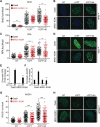The SWI/SNF ATPase BRG1 stimulates DNA end resection and homologous recombination by reducing nucleosome density at DNA double strand breaks and by promoting the recruitment of the CtIP nuclease
- PMID: 33044911
- PMCID: PMC7714457
- DOI: 10.1080/15384101.2020.1831256
The SWI/SNF ATPase BRG1 stimulates DNA end resection and homologous recombination by reducing nucleosome density at DNA double strand breaks and by promoting the recruitment of the CtIP nuclease
Abstract
DNA double strand breaks (DSBs) are among the most toxic DNA lesions and can be repaired accurately through homologous recombination (HR). HR requires processing of the DNA ends by nucleases (DNA end resection) in order to generate the required single-stranded DNA (ssDNA) regions. The SWI/SNF chromatin remodelers are 10-15 subunit complexes that contain one ATPase (BRG1 or BRM). Multiple subunits of these complexes have recently been identified as a novel family of tumor suppressors. These complexes are capable of remodeling chromatin by pushing nucleosomes along the DNA. More recent studies have identified these chromatin remodelers as important factors in DNA repair. Using the DR-U2OS reporter system, we show that the down regulation of BRG1 significantly reduces HR efficiency, while BRM has a minor effect. Inactivation of BRG1 impairs DSB repair and results in a defect in DNA end resection, as measured by the amount of BrdU-containing ssDNA generated after DNA damage. Inactivation of BRG1 also impairs the activation of the ATR kinase, reduces the levels of chromatin-bound RPA, and reduces the number of RPA and RAD51 foci after DNA damage. This defect in DNA end resection is explained by the defective recruitment of GFP-CtIP to laser-induced DSBs in the absence of BRG1. Importantly, we show that BRG1 reduces nucleosome density at DSBs. Finally, inactivation of BRG1 renders cells sensitive to anti-cancer drugs that induce DSBs. This study identifies BRG1 as an important factor for HR, which suggests that BRG1-mutated cancers have a DNA repair vulnerability that can be exploited therapeutically.
Keywords: DNA end resection; DSB repair; SWI/SNF; chromatin remodelers; genomic instability; homologous recombination.
Conflict of interest statement
The authors declare no conflict of interests.
Figures






Similar articles
-
BRG1 promotes the repair of DNA double-strand breaks by facilitating the replacement of RPA with RAD51.J Cell Sci. 2015 Jan 15;128(2):317-30. doi: 10.1242/jcs.159103. Epub 2014 Nov 13. J Cell Sci. 2015. PMID: 25395584 Free PMC article.
-
The chromatin-remodeling subunit Baf200 promotes homology-directed DNA repair and regulates distinct chromatin-remodeling complexes.J Biol Chem. 2017 May 19;292(20):8459-8471. doi: 10.1074/jbc.M117.778183. Epub 2017 Apr 5. J Biol Chem. 2017. PMID: 28381560 Free PMC article.
-
The SWI/SNF ATP-dependent nucleosome remodeler promotes resection initiation at a DNA double-strand break in yeast.Nucleic Acids Res. 2017 Jun 2;45(10):5887-5900. doi: 10.1093/nar/gkx221. Nucleic Acids Res. 2017. PMID: 28398510 Free PMC article.
-
The role of the SWI/SNF chromatin remodelling complex in the response to DNA double strand breaks.DNA Repair (Amst). 2020 Sep;93:102919. doi: 10.1016/j.dnarep.2020.102919. DNA Repair (Amst). 2020. PMID: 33087260 Review.
-
An insight into understanding the coupling between homologous recombination mediated DNA repair and chromatin remodeling mechanisms in plant genome: an update.Cell Cycle. 2021 Sep;20(18):1760-1784. doi: 10.1080/15384101.2021.1966584. Epub 2021 Aug 26. Cell Cycle. 2021. PMID: 34437813 Free PMC article. Review.
Cited by
-
The SMARCD Family of SWI/SNF Accessory Proteins Is Involved in the Transcriptional Regulation of Androgen Receptor-Driven Genes and Plays a Role in Various Essential Processes of Prostate Cancer.Cells. 2022 Dec 28;12(1):124. doi: 10.3390/cells12010124. Cells. 2022. PMID: 36611918 Free PMC article.
-
Different SWI/SNF complexes coordinately promote R-loop- and RAD52-dependent transcription-coupled homologous recombination.Nucleic Acids Res. 2023 Sep 22;51(17):9055-9074. doi: 10.1093/nar/gkad609. Nucleic Acids Res. 2023. PMID: 37470997 Free PMC article.
-
The role of chromatin remodeler SMARCA4/BRG1 in brain cancers: a potential therapeutic target.Oncogene. 2023 Jul;42(31):2363-2373. doi: 10.1038/s41388-023-02773-9. Epub 2023 Jul 11. Oncogene. 2023. PMID: 37433987 Free PMC article. Review.
-
Case Report: Gastrointestinal neuroendocrine carcinoma with SMARCA4 deficiency: a clinicopathological report of two rare cases.Front Oncol. 2023 Nov 28;13:1290717. doi: 10.3389/fonc.2023.1290717. eCollection 2023. Front Oncol. 2023. PMID: 38090508 Free PMC article.
-
SWI/SNF complexes in hematological malignancies: biological implications and therapeutic opportunities.Mol Cancer. 2023 Feb 21;22(1):39. doi: 10.1186/s12943-023-01736-8. Mol Cancer. 2023. PMID: 36810086 Free PMC article. Review.
References
-
- Ranjha L, Howard SM, Cejka P.. Main steps in DNA double-strand break repair: an introduction to homologous recombination and related processes. Chromosoma. 2018. June;127(2):187–214. - PubMed
-
- Talens F, Jalving M, Gietema JA, et al. Therapeutic targeting and patient selection for cancers with homologous recombination defects. Expert Opin Drug Discov. 2017. June;12(6):565–581. - PubMed
Publication types
MeSH terms
Substances
LinkOut - more resources
Full Text Sources
Other Literature Sources
Research Materials
Miscellaneous
